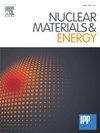Assessing the toroidal radiation distribution at Wendelstein 7-X by combining Gaussian Process Tomography and field line mapping
IF 2.3
2区 物理与天体物理
Q1 NUCLEAR SCIENCE & TECHNOLOGY
引用次数: 0
Abstract
Radiative cooling is one of the main heat dissipation channels for magnetically confined fusion plasmas. In stellarators power exhaust control is complicated by the three-dimensional radiation distribution. Using a Gaussian Process Tomography routine, the two-dimensional radiation distribution in Wendelstein 7-X is reconstructed from the line-integrated bolometer data of one poloidal cross-section. These experimental tomograms are mapped to the field of view of the newly installed divertor bolometer cameras and compared to the toroidally separated local measurements to assess the toroidal radiation distribution. We observe peaking of the plasma radiated power density in the divertor region and steep toroidal gradients, especially at low radiated power fraction (up to increase in the emissivity along a m long flux tube). These results suggest the presence of significant toroidal radiation asymmetries within a stellarator half-module.
求助全文
约1分钟内获得全文
求助全文
来源期刊

Nuclear Materials and Energy
Materials Science-Materials Science (miscellaneous)
CiteScore
3.70
自引率
15.40%
发文量
175
审稿时长
20 weeks
期刊介绍:
The open-access journal Nuclear Materials and Energy is devoted to the growing field of research for material application in the production of nuclear energy. Nuclear Materials and Energy publishes original research articles of up to 6 pages in length.
 求助内容:
求助内容: 应助结果提醒方式:
应助结果提醒方式:


